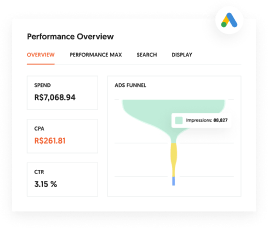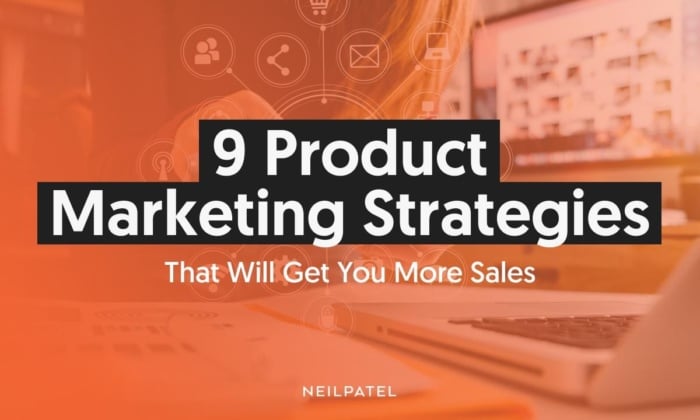
You know the saying, “Fail to plan, and you plan to fail?” That might explain why so many businesses fold.
The stats are scary. Of the 30,000-plus products launched every year, 95 percent end in failure.
You know why? Well, one of the biggest problems companies face when launching a new product is a lack of preparation.
What can you do to change the odds in your favor? While there are never any guarantees of success, a solid product marketing strategy can help mitigate many risk factors and help you plan for tough times.
That’s what I’m talking about today: implementing product marketing strategies to get more sales and keep your business on solid ground.
Sound good? Then let’s begin with the basics.
What Is Product Marketing?
Product marketing is the process of bringing a new product to market. That includes the research and development stages, your product launch strategies, and beyond.
Effective product marketing requires a well-planned strategy and a deep understanding of your audience’s needs and wants. Then, by using the right tone and messaging, you can effectively communicate your product’s benefits, drive sales, and grow your business.
Whether you’re launching your first product or your fiftieth, having some product marketing strategies to guide your way can give you everything you need to achieve your business goals.
Benefits of Product Marketing
The main benefit of product marketing is improved sales. However, an effective product marketing strategy can have more benefits than “mere” profit.
First, product marketing helps you to position your product, leading to successful targeting and reduced advertising spending.
Also, a proper product market strategy answers questions like “What product gap needs to be filled?” and “How does my product stand out from the competition?”
Other advantages of using product marketing strategies include:
- Increased brand recognition and awareness
- Ability to demonstrate unique features and benefits of the product
- Improved customer trust and loyalty
- Increased sales and revenue
- Giving your company a competitive edge in the market
- Helping you target the right audience and generate leads
- Gaining insights into customer needs and preferences
- Providing opportunities for customer engagement and feedback
- Enhancing the overall customer experience
- Building relationships and partnerships with other businesses
In addition, you’ll get to unlock new insights about your competitors. While this isn’t often a huge concern for smaller businesses, research shows that 26 percent of those surveyed intend to spend more on competitive intelligence. Along with that, 90 percent collect intel on competitors, and 53 percent collect info on perceived competitors.
Examples of Product Marketing
Before we get into the list of product marketing strategies, let’s look at two brands with successful campaigns.
1. Poo-Pourri
Poo-Pourri is a great example of a brand that executed product marketing for an otherwise embarrassing and taboo subject (a toilet spray that eliminates the unpleasant odors associated with the bathroom.) Yet, it does so with humor and relatability because, after all, everybody poops.
The company positioned its product perfectly.
Its first-ever video advertisement went viral. However, Poo-Pourri also gained a cult following that continued to grow over the years.

How can other brands learn from Poo-Pourri’s success?
First, find your platform and go hard. Poo-Pourri used video advertising in its early years to continue to grow its following. This included television and online advertising, where the brand could push the envelope with humor.
The company also used customer personas to its advantage. It’s true. Everybody poops. However, not everyone feels the need for a toilet spray.
Instead, Poo-Pourri’s advertisements targeted specific markets and situations to really drive its point home.
2. Tesla
When you think of Tesla, what comes to mind? Electric cars. Clean energy. Solar power.
Your mental alignment of Tesla with these keywords and others in the clean energy space is for one simple reason: it built its entire identity, including each product marketing strategy, around its brand statement.
Here’s a snippet of Tesla’s brand statement:
“Tesla builds not only all-electric vehicles but also infinitely scalable clean energy generation and storage products. Tesla believes the faster the world stops relying on fossil fuels and moves towards a zero-emission future, the better.”
Tesla effectively cornered the electric vehicle market (EV). It knew it had a target audience in the space. However, it always stayed within its brand statement when developing EVs and other clean energy products.
What does that success look like? Tesla currently boasts 50.5 percent of the electric car market share, and Tesla’s Model Y is the number one EV. Pretty impressive, I’m sure you’ll agree.
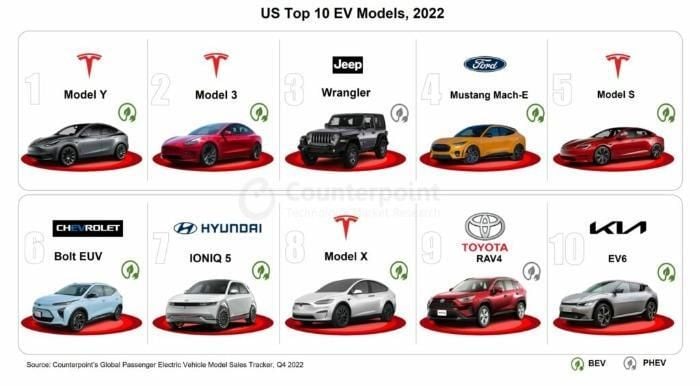
9 Product Marketing Strategies to Grow Your Business
You’ve seen a couple of examples. From these, you see how some of the biggest businesses in the world execute product marketing. How can you take this insight and apply it to your business or clients, though?
Let’s discuss the different strategies you can use to steer your business forward and keep it going in the right direction.
1. Pair With Robust Content Marketing
Do you ever think your product is too “boring” for content marketing to have an impact? Think again! With some creative thinking, you can make your less-than-exciting product sound like a whole lot of fun.
Let’s use Blendtec as an example.
A blender isn’t the most fun product in the world. However, the residential and commercial blender manufacturers created the inspired idea of a series of videos called “Will It Blend?” and it’s just what it sounds like.
The company test blended various inedible items as a way to inject curiosity and humor into its product line.

Did it work? Absolutely! Blendtec experienced a 700 percent increase in sales over its first three years.
While your content marketing strategy doesn’t have to be quite so outlandish, it can be just as successful. There are plenty of content types you could include in your strategy, like:
- blog posts
- videos
- podcasts
- infographics
- white papers
- downloadable guides
You just need to ensure your content marketing is compelling. Here’s how:
- First, understand what your customers need.
- Second, push on their pain points.
- Third, agitate that pain through storytelling.
- Finally, offer to solve their problem.
As long as you touch those four points, you can get your content marketing strategy off to a strong start.
2. Develop a Product Launch Plan
Product launches don’t always go as planned.
According to Gartner, 45 percent of product launches face delays of at least one month. This can lead to a domino effect of poor results.
While this is a bitter pill to swallow, it should also motivate you to invest time in a clear and detailed product marketing strategy.
Your product launch plan needs to be effective, on time, and successful, and consider these three stages:
- Pre-launch.
- Launch.
- Post-launch.
Pre-launch focuses on research and development. Consider what your industry is like, who your customers are, and what your product can offer that nothing else can.
This stage also requires extensive beta testing and finessing your messaging to your target audience.
During this phase, you need to ask questions such as:
- What unexpected pain points come up during beta?
- What is the feedback like?
- What can you improve in your product or messaging?
Launch is all about getting the message out to the right audience. This means choosing the best channels to reach your target market. You could even host multiple online and in-person events to generate a buzz.
Finally, post-launch requires you to evaluate your targets versus actuals. Did you perform as well as you hoped? If not, why?
A poor initial launch isn’t a loss. It’s important not to lose momentum during post-launch and, eventually, shift your focus to retaining existing customers.
3. Start ‘Piggybacking’ on Other People’s Platforms
Business success is often about timing. Catch a wave, and you could be well on your way to serving a niche and getting keen consumers lining up.
I mean it.
Moving too slowly and not acting when something is hot can kill new companies.
However, what if:
- Nobody knows who you are
- Consumers don’t trust you yet
- Shoppers aren’t searching for you by name
No worries. You can simply piggyback on other people’s platforms.
Here’s what I mean.
Airbnb started as a nobody. However, it embraced that and instead looked for places where its customers already were.
Back then, people still used Craigslist to find people in cities where they wanted to travel (or to offer up their couches).
Airbnb started by going after the people listing properties on Craigslist first.
It did that through simple tools that allowed them to cross-post their property listings on Airbnb’s platform.
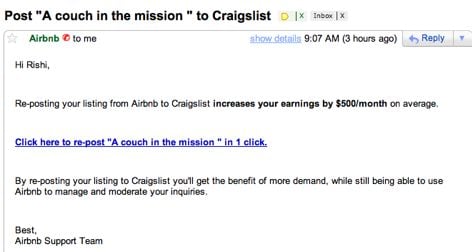
While this worked well, Airbnb still needed more. The only way to get the young company off the ground was to put its foot on the gas pedal to get more listings.
What it did was both clever and perhaps controversial.
Airbnb scrapped Craigslist contact information and then sent out mass emails to people like this one:
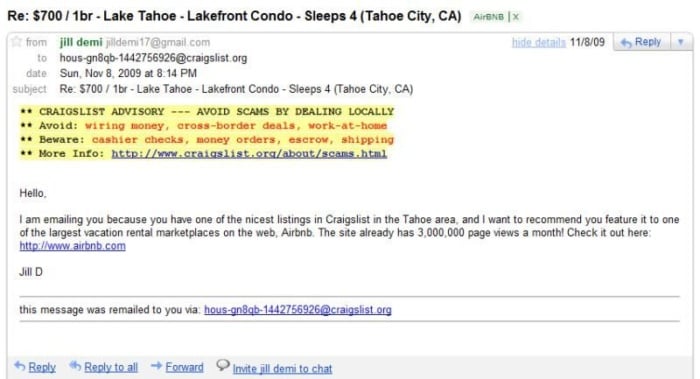
However, the good news is that you don’t always have to do something spammy or technical to get the same results.
For example, Unbounce was a brand-new company at one point. It was also self-funded, so it didn’t necessarily have the same resources as its competitors to make a huge splash.
Instead, Unbounce created its own publicity.
Co-founder Oli Gardner spent countless hours creating The Noob Guide to Online Marketing.
It contains a 15-million-pixel infographic that shows 60 different tasks in detail, along with a six-month course to help you figure out how to put all that information into practice.
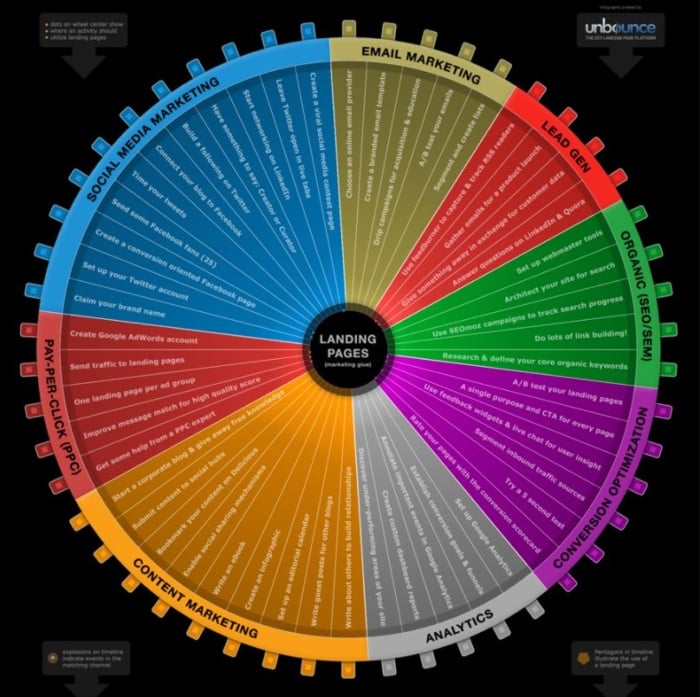
With something this big, your first natural inclination would be to put it on your own site so that you can receive all the benefits.
However, that’s not what Unbounce did.
Instead, the company posted the entire thing on the Moz blog for free.
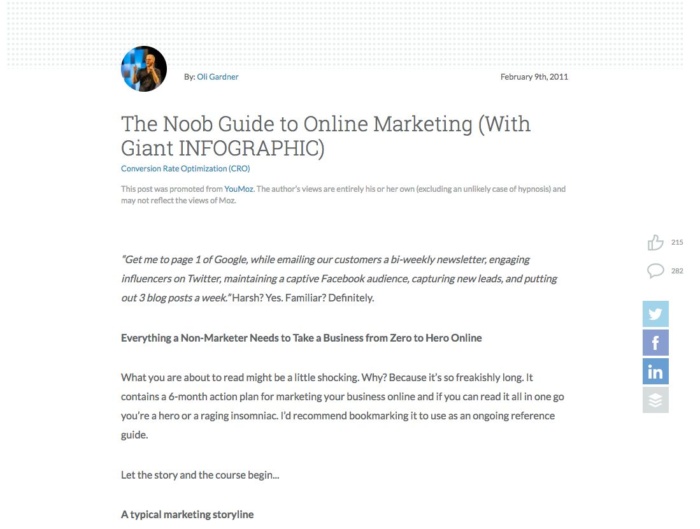
The reason was simple.
Unbounce needed attention and customers. Moz had those things; it was a match made in heaven.
You can replicate this same product marketing strategy almost anywhere you look.
For example, software companies often help each other run cross-promotions or partnerships when it’s mutually beneficial. Treehouse teaches people to code. Many of those people are freelancers, which makes Freshbooks a perfect fit.
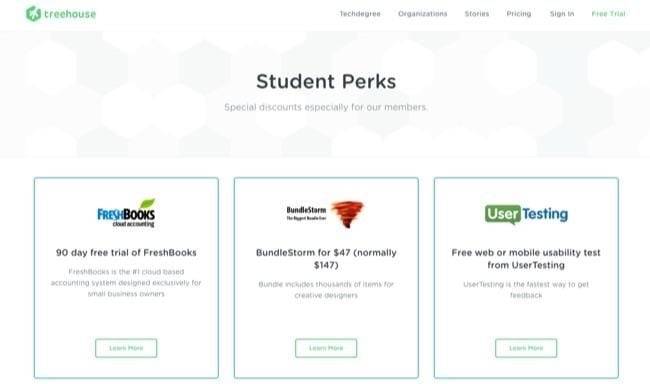
These can be ‘back-scratching’ relationships where no other value is traded. Or you could incentivize the bigger partner by giving them a cut of all the revenue you generate through the partnership.
4. Find An Influencer (or become one yourself) To Help Increase Your Brand’s Visibility
Influencers have the big, pre-built audiences you need access to, and they’re easy enough to find.
You could search for them on Instagram or use influencer marketplaces like TRIBE.
Here’s how it works.
You go on your chosen platform and simply list your products or describe your initial campaign idea.
Then you search for the influencer or let the site match you with someone. However, it will cost you. The entry-level Pro annual subscription has a minimum campaign value of $2,000, while the pay-per-use package is $3,000.
5. Retarget Your Existing Customers
Why would you want to market to your existing customer base (retargeting)? After all, you want to grow your business, right?
Seeking new customers is an approach many companies take. However, you’ll often find your existing buyers are your greatest source of revenue. Financial experts from Toptal.com provide a great example demonstrating how retention increases revenue below:
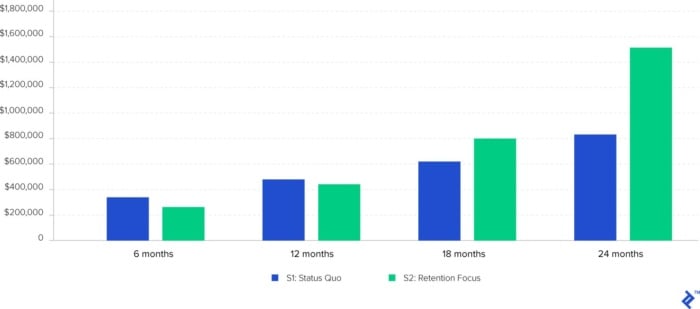
There are many reasons why you might struggle to retain buyers. Perhaps:
- your customer service is lacking
- the buyer is cutting back on spending
- there is a new competitor on the horizon
- a new trend is developing
You can’t do anything about any of that. However, with a proven product marketing strategy, you can retarget your existing customers. That is, marketing directly to them to address their needs and invoke feelings of brand loyalty.
What does retargeting look like? Well, you could:
- Create custom ad campaigns for previous and existing customers. Focus heavily on brand loyalty and customer satisfaction. Ask yourself, what is it that keeps customers coming back? Do more of it.
- Build a retargeting email campaign. Using segmentation, create different campaigns for customers who haven’t purchased over various periods (e.g., within the last three months, within the previous six months, etc.)
- Bid more aggressively on retargeting campaigns. Keep in mind, customers who previously converted are more likely to convert than new customers. This means you can afford to have a higher Cost Per Conversion (CPC) for retargeting campaigns.
Ultimately, your retargeting strategy aims to remind customers why they purchased from you in the first place. Therefore, emphasize their initial experience and the value your product offers.
6 Address Customer Pain Points
63 percent of B2C, and 76 percent of B2B customers expect businesses to anticipate and address their needs. It sounds like a tough demand, right? However, all it takes is understanding your customers’ pain points (challenges) and addressing them with your products and services.
Pain points are vital to any marketing strategy but can often be overlooked in e-commerce. They are an important part of the marketing mix because they:
- help move a customer to action.
- create a sense of relief in a customer.
- tighten the conversion funnel.
- improve conversion rates.
If you’re wondering how to identify common pain points, surveys are always a good idea. You could also try competitive analysis, asking on social media, or using social listening tools.
Take Qdoba, for example. The brand knows that additional charges for popular add-ons, like guacamole or queso, are a pain point for its customer base. The solution? It doesn’t charge extra.
Pain points don’t stop with the purchase of your product, though. You should also have a plan in place for when your customers experience difficulties during the usual customer service journey. For instance, an issue with a faulty product.
In this example, solutions include offering live chats with customer service agents, addressing problems quickly, and ensuring the buyer is happy with the outcome.
Of course, I’m simplifying things there, but fixing common problems needn’t be complicated.
7. Reevaluate and Improve Product Positioning
Just because you’ve launched your product, it doesn’t mean you need to stick with your chosen markets and product marketing strategies. In fact, the launch may highlight a new possible niche for your product or even a unique value proposition.
Below are the three stages of a typical launch:
In the planning phase or pre-launch, you and your product team would have answered questions like:
- Why are we making this product?
- Who is this product made for?
- What challenges does this product resolve?
- What makes this product unique?
Then, post-launch, it’s time to consider whether the answers you and your team came up with held true. If not, what do the new answers look like, and how do they differ from the original plan?
That difference can give you a whole new idea for repositioning your product in the ever-changing market.
Product repositioning refers to the process of changing the target market or brand image of a product or service. This is often done in response to changes in the market or competitive landscape or to better align with evolving consumer needs.
An example is a luxury watch company selling to high-end consumers but noticing a growing demand for affordable, eco-friendly products. To reposition the brand, the business begins selling a line of sustainable and affordable watches marketed towards environmentally-conscious millennials.
This involves a shift in marketing strategy and changes to the product design and packaging to better align with its target market’s needs and values.
Fortunately, once you go to market, you have the value of customer insights and their feedback. Use this to implement a full product positioning strategy and evolve if needed.
8. Consider a Change to Your Pricing Structure
Another way to reposition your product is to consider changing your pricing structure. This is one of the best neuroscience tips to boost your sales that I can give you. Why? Because different pricing structures can have varying effects on consumer behavior.
Altering pricing can be as simple as lowering (or increasing) your price or running exclusive promotions.
You can also follow the likes of Peloton and hundreds of other companies who successfully implemented the “good-better-best” approach to pricing.
In short, the good-better-best product marketing strategy involves three tiers of the same item with increasing value. This enables you to make your merchandise more accessible to new customers while enhancing spending for customers who want more.
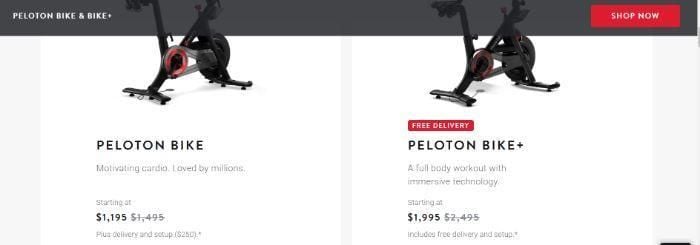
An example of a pricing structure from Peloton.
To continue with the Peloton example, you’ve got several products to choose from:
- The Peloton Bike (starting at $1,445).
- The Peloton Bike+ (starting at $2,495).
- The Peloton Tread (starting at $3,495).
- The Peloton Tread+ (starting at $4,295 basics package).
While the Peloton Bike and the Peloton Tread are unique products, they still offer one experience for the customer: a home workout device.
Offering your product at various price points opens it up to more customers. This can be a good step for companies hoping to break into more markets.
9. Attend, Organize, and Volunteer At Events
People love putting a face to a name. That’s why many consumers prefer doing business in person.
It’s infinitely easier to gain someone’s trust and discuss your ever-evolving positioning when you’re face-to-face.
Here’s an example.
In the early days, the founders from Hakka Labs attended local meetups to learn more about what interested the engineering community.
The discussions were often valuable, but there was never any record of them afterward. In other words, the information and insight exchanged vanished after the event was over.
The answer was simple enough: Hakka Labs started recording the talks and making the audio available for users on its website.
The organizers could listen to the file and happily help share the information with all the group members.
You can then scale this approach by inviting more people to attend additional events, then rinse and repeat as necessary.
This approach proved so successful that it eventually expanded into hosting its own meetups. Before long, it launched an entire conference for the same communities it was reaching.
This early traction helped them pick up a $500k angel investment (after bootstrapping this entire time).
It’s the same basic platform piggybacking strategy, but you take it offline and meet people in person.
This type of strategy helps you stand out, too.
Think about it: Everyone sends out cold emails to get noticed, but they aren’t always the best option. The response rate is abysmal, so why waste your effort?
Instead, do something different, like meeting people at events or sending new prospects something in the mail to gain attention.
It takes more effort but also helps you gain traction and get in front of prospects.
Frequently Asked Questions
Convenience products: Everyday items that customers need and are readily available. Examples include bread, milk, and toiletries.
Shopping products: Items that customers buy less frequently and spend more time and effort comparing before making a purchase. Examples include smartphones, laptops, and cars.
Specialty products: Unique and high-end products that customers are willing to go out of their way to purchase. Examples are luxury watches, high-end fashion items, and gourmet food products.
Unsought products: items that customers may not know they need or want until they see them, like insurance policies and emergency car repair services.
By understanding the product you are selling, you can tailor and clarify your marketing strategy to best reach your target audience.
For example, if you sell convenience products, you may want to focus on making your products easily accessible and affordable. On the other hand, if you are selling specialty products, you may want to highlight your products’ unique features and craftsmanship to justify a higher price point.
Product marketing can benefit every type of enterprise, from small startups to large corporations. Whether you’re selling physical products like clothing or electronics, or digital products like software or online courses, using effective product marketing strategies is essential to attracting and retaining customers.
Influencer marketing: People who have a large social media following to promote your product. An example is a beauty brand partnering with a popular beauty blogger to promote their new makeup line.
Content marketing: Involves creating and sharing informative, engaging content that drives brand awareness and generates leads. Examples include blog posts, videos, and infographics.
Email marketing: Where you send personalized emails to subscribers to promote your products or services, such as newsletters and promotional emails.
Social media marketing: Using social media platforms like Facebook, Instagram, and Twitter to promote your products and engage with your audience using sponsored posts and social media ads, for example.
Search engine marketing: Paid advertising to appear at the top of search engine results pages (SERPs) for specific keywords related to your product. Examples include Google Ads and Bing Ads.
You could also use traditional marketing (print ads or TV), word-of-mouth, guerilla (unusual marketing tactics), or in-store marketing.
While marketing may involve creating and promoting a brand image, product marketing focuses more on the unique features and benefits of a specific product.
Product marketers work to understand the target audience, position the product in the marketplace, and differentiate it from competitors. They also create a demand for goods through various product marketing strategies.
Conclusion
From product development to customer analysis to launch, implementing product marketing strategies can ensure you hit all the milestones in a set timeline.
In turn, you can launch your product on time and increase your odds of success.
As long as you have a solid product marketing strategy that mitigates risks and anticipates customer needs, you’ll be off to a better start than most companies.
Common product marketing strategies you can use include reevaluating and repositioning, using a content marketing plan, and retargeting existing customers.
Test your chosen strategies, find what works for you, and go with it to keep building traction and moving forward.
Which product marketing strategy will you use for your upcoming product launches?

See How My Agency Can Drive More Traffic to Your Website
- SEO - unlock more SEO traffic. See real results.
- Content Marketing - our team creates epic content that will get shared, get links, and attract traffic.
- Paid Media - effective paid strategies with clear ROI.
Are You Using Google Ads? Try Our FREE Ads Grader!
Stop wasting money and unlock the hidden potential of your advertising.
- Discover the power of intentional advertising.
- Reach your ideal target audience.
- Maximize ad spend efficiency.

